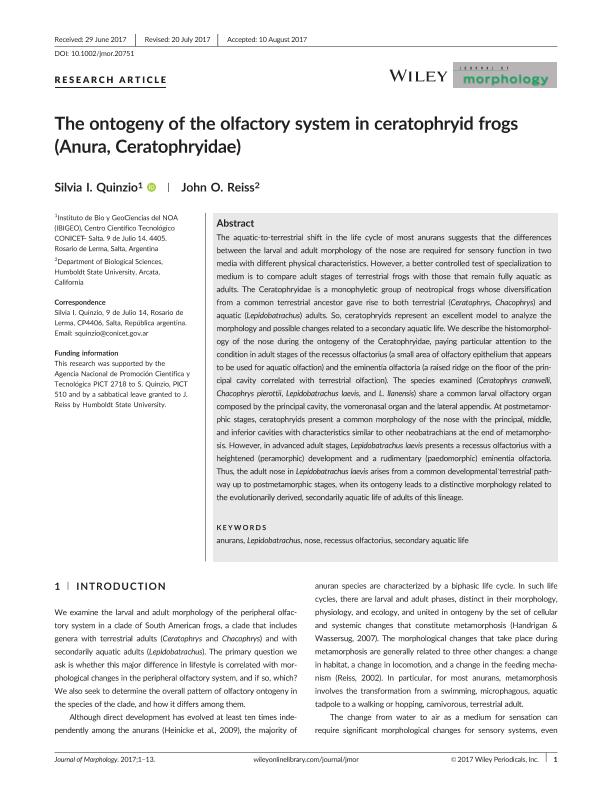Mostrar el registro sencillo del ítem
dc.contributor.author
Quinzio, Silvia Inés

dc.contributor.author
Reiss, John
dc.date.available
2018-06-29T12:51:03Z
dc.date.issued
2018-01
dc.identifier.citation
Quinzio, Silvia Inés; Reiss, John; The ontogeny of the olfactory system in ceratophryid frogs (Anura, Ceratophryidae); Wiley-liss, Div John Wiley & Sons Inc; Journal of Morphology; 279; 1; 1-2018; 37-49
dc.identifier.issn
0362-2525
dc.identifier.uri
http://hdl.handle.net/11336/50564
dc.description.abstract
The aquatic-to-terrestrial shift in the life cycle of most anurans suggests that the differences between the larval and adult morphology of the nose are required for sensory function in two media with different physical characteristics. However, a better controlled test of specialization to medium is to compare adult stages of terrestrial frogs with those that remain fully aquatic as adults. The Ceratophryidae is a monophyletic group of neotropical frogs whose diversification from a common terrestrial ancestor gave rise to both terrestrial (Ceratophrys, Chacophrys) and aquatic (Lepidobatrachus) adults. So, ceratophryids represent an excellent model to analyze the morphology and possible changes related to a secondary aquatic life. We describe the histomorphology of the nose during the ontogeny of the Ceratophryidae, paying particular attention to the condition in adult stages of the recessus olfactorius (a small area of olfactory epithelium that appears to be used for aquatic olfaction) and the eminentia olfactoria (a raised ridge on the floor of the principal cavity correlated with terrestrial olfaction). The species examined (Ceratophrys cranwelli, Chacophrys pierottii, Lepidobatrachus laevis, and L. llanensis) share a common larval olfactory organ composed by the principal cavity, the vomeronasal organ and the lateral appendix. At postmetamorphic stages, ceratophryids present a common morphology of the nose with the principal, middle, and inferior cavities with characteristics similar to other neobatrachians at the end of metamorphosis. However, in advanced adult stages, Lepidobatrachus laevis presents a recessus olfactorius with a heightened (peramorphic) development and a rudimentary (paedomorphic) eminentia olfactoria. Thus, the adult nose in Lepidobatrachus laevis arises from a common developmental ‘terrestrial’ pathway up to postmetamorphic stages, when its ontogeny leads to a distinctive morphology related to the evolutionarily derived, secondarily aquatic life of adults of this lineage.
dc.format
application/pdf
dc.language.iso
eng
dc.publisher
Wiley-liss, Div John Wiley & Sons Inc

dc.rights
info:eu-repo/semantics/openAccess
dc.rights.uri
https://creativecommons.org/licenses/by-nc-sa/2.5/ar/
dc.subject
Anurans
dc.subject
Lepidobatrachus
dc.subject
Nose
dc.subject
Recessus Olfactorius
dc.subject
Secondary Aquatic Life
dc.subject.classification
Otras Ciencias Biológicas

dc.subject.classification
Ciencias Biológicas

dc.subject.classification
CIENCIAS NATURALES Y EXACTAS

dc.title
The ontogeny of the olfactory system in ceratophryid frogs (Anura, Ceratophryidae)
dc.type
info:eu-repo/semantics/article
dc.type
info:ar-repo/semantics/artículo
dc.type
info:eu-repo/semantics/publishedVersion
dc.date.updated
2018-06-19T15:59:33Z
dc.journal.volume
279
dc.journal.number
1
dc.journal.pagination
37-49
dc.journal.pais
Estados Unidos

dc.description.fil
Fil: Quinzio, Silvia Inés. Consejo Nacional de Investigaciones Científicas y Técnicas. Centro Científico Tecnológico Conicet - Salta. Instituto de Bio y Geociencias del NOA. Universidad Nacional de Salta. Facultad de Ciencias Naturales. Museo de Ciencias Naturales. Instituto de Bio y Geociencias del NOA; Argentina
dc.description.fil
Fil: Reiss, John. University Arcata; Estados Unidos
dc.journal.title
Journal of Morphology

dc.relation.alternativeid
info:eu-repo/semantics/altIdentifier/doi/http://dx.doi.org/10.1002/jmor.20751
dc.relation.alternativeid
info:eu-repo/semantics/altIdentifier/url/https://onlinelibrary.wiley.com/doi/abs/10.1002/jmor.20751
Archivos asociados
